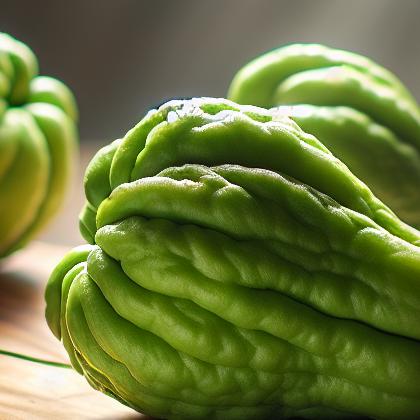Chayote

Chayote (Sechium edule), also known as christophene or christophine, cho-cho, mirliton or merleton (Creole/Cajun), chuchu (Brazil), Cidra (Antioquia, Caldas, Quindio and Risaralda regions of Colombia), Guatila (Boyacá and Valle del Cauca regions of Colombia), Centinarja (Malta), Pipinola (Hawaii), pear squash, vegetable pear, chouchoute, choko, güisquil (El Salvador), Labu Siam (Indonesia), Ishkus (Darjeeling, India), Pataste (Honduras),Tayota (Dominican Republic), Sayote (Philippines) is an edible plant belonging to the gourd family Cucurbitaceae, along with melons, cucumbers and squash.Chayote is originally native to Mexico where it grows abundantly and has little commercial value. It has been introduced as a crop all over Latin America, and worldwide. The main growing regions are Brazil, Costa Rica and Veracruz, Mexico. Costa Rican chayotes are predominantly exported to the European Union, whereas Veracruz is the main exporter of chayotes to the United States.The word chayote is a Spanish derivative of the Nahuatl word chayohtli (pronounced [t͡ʃaˈjoʔt͡ɬi]). Chayote was one of the many foods introduced to Europe by early explorers, who brought back a wide assortment of botanical samples. The Age of Conquest also spread the plant south from Mexico, ultimately causing it to be integrated into the cuisine of many other Latin American nations.The chayote fruit is used in mostly cooked forms. When cooked, chayote is usually handled like summer squash, it is generally lightly cooked to retain the crisp flavor. Though rare and often regarded as especially unpalatable and tough in texture, raw chayote may be added to salads or salsas, most often marinated with lemon or lime juice. Whether raw or cooked, chayote is a good source of amino acids and vitamin C.Although most people are familiar only with the fruit as being edible, the root, stem, seeds and leaves are as well. The tubers of the plant are eaten like potatoes and other root vegetables, while the shoots and leaves are often consumed in salads and stir fries, especially in Asia. Like other members of the gourd family, such as cucumbers, melons, and squash, chayote has a sprawling habit, and it should only be planted if there is plenty of room in the garden. The roots are also highly susceptible to rot, especially in containers, and the plant in general is finicky to grow. However, in Australia and New Zealand, it is an easily grown yard or garden plant, set on a chicken wire support or strung against a fence.
Chayote Pairs With:

Chayote Properties:
| Food Property | Type | Description |
|---|---|---|
| Flavor Profile | Sweet | Chayote has a mild sweetness similar to a cucumber or zucchini. |
| Sour | Chayote is not sour in flavor. | |
| Salty | Chayote is not salty in flavor. | |
| Bitter | Chayote is not bitter in flavor. | |
| Umami | Chayote has a subtle umami flavor. | |
| Texture | Firmness | Chayote has a firm texture similar to a potato when cooked. |
| Tenderness | Chayote becomes tender when cooked. | |
| Nutritional Value | Fiber | Chayote is a good source of dietary fiber. |
| Micronutrients | Chayote contains vitamins and minerals such as vitamin C, vitamin B6, folate, and potassium. | |
| Color | Natural Pigments | Chayote is typically light green in color. |
| Aroma | Volatile Compounds | Chayote has a subtle, fresh aroma similar to a cucumber. |
Food Pairing App - Version 1.2.0
